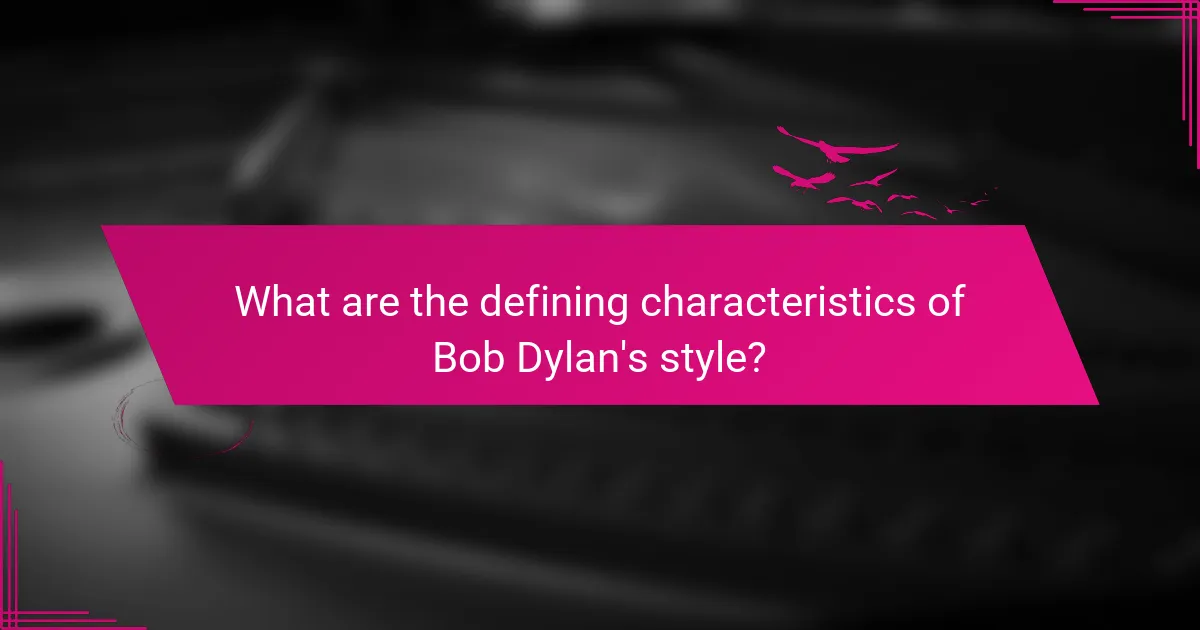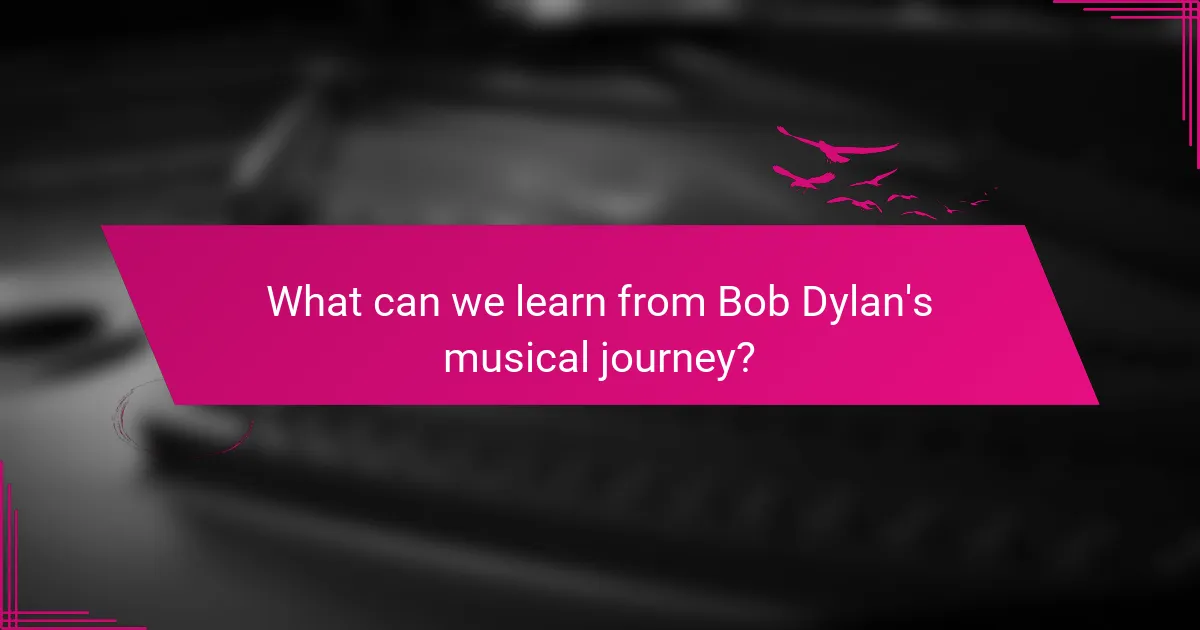Bob Dylan is a pivotal figure in music history, known for revolutionizing folk music by incorporating rock elements and addressing social and political themes in his lyrics. His transition from acoustic to electric guitar in the 1960s marked a significant shift in genre boundaries, influencing a wide range of artists across rock, country, and pop. Dylan’s unique vocal style, complex imagery, and storytelling abilities set him apart, earning him numerous accolades, including the Nobel Prize in Literature in 2016. The article explores Dylan’s early years, his innovative lyricism, and his genre-bending approach, highlighting his lasting impact on modern music and the importance of adaptability in artistic expression.

What is the Musical Influence of Bob Dylan?
Bob Dylan’s musical influence is profound and far-reaching. He revolutionized folk music by integrating rock elements into his sound. His lyrics often explore social and political themes, which inspired subsequent generations of songwriters. Dylan’s shift from acoustic to electric guitar in the 1960s marked a pivotal moment in music history. This transition challenged traditional genre boundaries and encouraged artists to experiment. His work has influenced various genres, including rock, country, and pop. Many notable musicians, such as Bruce Springsteen and Joan Baez, cite Dylan as a major influence. His songwriting has earned him numerous awards, including the Nobel Prize in Literature in 2016, recognizing his impact on culture and music.
How did Bob Dylan’s early years shape his music?
Bob Dylan’s early years significantly influenced his music. He grew up in a small town in Minnesota. This environment exposed him to various musical styles, including folk and blues. Dylan’s family listened to diverse music, which shaped his artistic perspective. He was inspired by folk legends like Woody Guthrie. His early experiences with literature and poetry also informed his songwriting. This background contributed to his unique lyrical depth. These formative years laid the groundwork for his innovative approach to music.
What childhood experiences influenced Bob Dylan’s artistic development?
Bob Dylan’s childhood experiences significantly influenced his artistic development. Growing up in Hibbing, Minnesota, he was exposed to a diverse musical environment. His family listened to a range of genres, including folk, blues, and rock. Dylan’s early exposure to folk music, particularly through artists like Woody Guthrie, shaped his songwriting style.
Attending the local high school, he formed a band called The Golden Chords. This early involvement in music fostered his passion for performance and songwriting. Dylan also experienced a sense of isolation during his youth, which fueled his introspective lyrics.
His family’s love for literature introduced him to poetry, further refining his lyrical abilities. These childhood experiences collectively laid the foundation for his later success as a groundbreaking musician and songwriter.
How did the cultural environment of the 1960s impact Dylan’s music?
The cultural environment of the 1960s significantly influenced Bob Dylan’s music. The decade was marked by social upheaval, civil rights movements, and anti-war protests. Dylan’s lyrics reflected these themes, addressing issues like injustice and inequality. His song “The Times They Are a-Changin'” became an anthem for change and social awareness. The folk music revival also shaped his style, merging traditional sounds with contemporary issues. Dylan’s engagement with the counterculture movement further propelled his artistic evolution. The interplay of music and activism in the 1960s created a fertile ground for Dylan’s innovative approach. His work resonated with a generation seeking authenticity and truth in art.
What are the key themes in Bob Dylan’s lyricism?
Bob Dylan’s lyricism features key themes of social justice, love, and existential questioning. Social justice is prominent in songs like “The Times They Are a-Changin’,” which calls for change and awareness. Love is explored in various forms, from romantic to unrequited, evident in tracks like “Make You Feel My Love.” Existential questioning appears in songs such as “Like a Rolling Stone,” reflecting on identity and purpose. Dylan often employs vivid imagery and metaphor, enhancing the emotional depth of his themes. His work reflects the cultural and political upheaval of the 1960s, making his lyrics timeless and relevant.
How does Dylan use storytelling in his lyrics?
Bob Dylan uses storytelling in his lyrics to convey complex narratives and emotions. His songs often feature vivid characters and detailed scenarios. For example, in “Tangled Up in Blue,” he presents a nonlinear narrative that explores themes of love and loss. Dylan incorporates elements of folk tradition, drawing from historical events and personal experiences. His use of imagery and metaphor enhances the storytelling aspect. Songs like “Hurricane” tell real-life stories of injustice and social issues. Through his lyrics, Dylan creates a tapestry of human experience, making listeners reflect on broader societal themes. This narrative style has influenced countless artists across genres.
What social and political messages are present in Dylan’s songs?
Bob Dylan’s songs convey powerful social and political messages. His lyrics often address civil rights, war, and social justice. For instance, “Blowin’ in the Wind” poses rhetorical questions about peace and freedom. This song became an anthem for the civil rights movement in the 1960s. Additionally, “The Times They Are a-Changin'” reflects societal changes and calls for political action. Dylan’s protest songs critique government policies and war, notably in “Masters of War.” His work has influenced generations, making him a key figure in political music. Dylan’s ability to articulate the struggles of his time resonates with listeners and inspires activism.
In what ways did Bob Dylan redefine musical genres?
Bob Dylan redefined musical genres by blending folk, rock, blues, and country elements. His transition from acoustic folk to electric rock in the 1960s was groundbreaking. The release of “Like a Rolling Stone” in 1965 marked a pivotal moment in rock music. This song featured complex lyrics and a distinctive sound that influenced future artists. Dylan’s use of poetic storytelling elevated the lyrical quality in popular music. He incorporated social and political themes, challenging traditional norms. His genre-bending approach inspired countless musicians across various styles. Dylan’s work reshaped the boundaries of what popular music could convey.
How did Dylan blend folk, rock, and blues in his work?
Bob Dylan blended folk, rock, and blues through innovative songwriting and musical experimentation. He incorporated folk traditions in his lyrics and acoustic guitar style. His early albums featured storytelling elements found in folk music. Dylan then introduced electric instruments, merging rock elements into his sound. This shift is evident in his 1965 album “Highway 61 Revisited.” He also embraced blues rhythms and structures, evident in songs like “Like a Rolling Stone.” Dylan’s unique vocal delivery combined these genres, creating a distinctive sound. His work influenced countless artists across multiple genres, solidifying his role as a genre-bending musician.
What innovations did Dylan introduce to popular music?
Bob Dylan introduced several key innovations to popular music. He transformed songwriting by blending poetic lyrics with music. His incorporation of folk elements into rock music created a new genre. Dylan’s use of electric instruments at the Newport Folk Festival in 1965 marked a pivotal shift in music. He challenged traditional song structures, often using unconventional narratives. Dylan’s songs addressed social and political issues, influencing a generation. His work paved the way for future artists to explore deeper themes. These innovations reshaped the landscape of popular music profoundly.
How does Bob Dylan’s influence extend beyond music?
Bob Dylan’s influence extends beyond music into literature, politics, and culture. His songwriting has been recognized for its poetic qualities, earning him the Nobel Prize in Literature in 2016. Dylan’s lyrics often reflect social and political themes, inspiring movements such as civil rights and anti-war protests in the 1960s. He has influenced countless writers and artists across various genres, shaping the landscape of modern poetry and storytelling. Additionally, his work has been analyzed in academic settings, highlighting its impact on American literature and cultural discourse. Dylan’s persona and artistry have also influenced film, visual arts, and fashion, making him a multifaceted cultural icon.
What impact has Dylan had on contemporary artists?
Bob Dylan has profoundly influenced contemporary artists across various genres. His innovative songwriting reshaped the landscape of popular music. Dylan’s focus on lyrical depth inspired countless musicians to prioritize storytelling in their work. Artists like Bruce Springsteen and Joni Mitchell cite Dylan as a major influence on their songwriting. His blending of folk, rock, and blues created a template for genre fusion. Dylan’s willingness to tackle social issues in his music encouraged artists to engage with political themes. The 1965 album “Highway 61 Revisited” marked a turning point in rock music, showcasing the potential of electric instrumentation. His impact is evident in the works of modern artists such as Taylor Swift and The National.
How has Dylan’s work influenced literature and culture?
Bob Dylan’s work has profoundly influenced literature and culture through his innovative lyricism and storytelling. His songs often incorporate poetic elements, drawing from various literary traditions. Dylan’s use of vivid imagery and complex themes has inspired countless writers and musicians. He has blurred the lines between music and poetry, elevating song lyrics to an art form. His influence is evident in the works of contemporary artists across multiple genres. The Nobel Prize in Literature awarded to him in 2016 highlights his impact on literary culture. Dylan’s ability to address social and political issues resonates deeply with audiences, shaping cultural discourse. His work continues to inspire new generations of artists and thinkers.

What are the defining characteristics of Bob Dylan’s style?
Bob Dylan’s style is characterized by his unique blend of folk, rock, and blues influences. His lyrics often feature complex imagery and social commentary. Dylan’s vocal delivery is distinct, marked by a raspy tone and unconventional phrasing. He frequently employs stream-of-consciousness techniques in his songwriting. His use of metaphor and symbolism adds depth to his work. Dylan’s ability to shift genres, from folk to electric rock, showcases his versatility. He is known for his storytelling ability, creating vivid narratives within his songs. His influence on songwriting is profound, shaping the landscape of modern music.
How does Bob Dylan’s vocal style contribute to his music?
Bob Dylan’s vocal style is a distinctive element that significantly contributes to his music. His voice features a unique blend of raspy tones and emotional delivery. This style enhances the storytelling quality of his lyrics. Dylan’s phrasing often emphasizes the emotional weight of his songs. His vocal inflections can convey irony, urgency, or intimacy. This versatility allows him to cross genres seamlessly. Critics often note that his singing evokes a sense of authenticity. For example, his performance of “Like a Rolling Stone” showcases this raw emotional power. Dylan’s vocal style remains a defining aspect of his influence in music history.
What techniques does Dylan use to convey emotion in his singing?
Bob Dylan uses vocal inflections, phrasing, and dynamic contrasts to convey emotion in his singing. His vocal inflections often include subtle variations in pitch and tone. This technique helps to express feelings like sadness or joy. Dylan’s unique phrasing allows him to emphasize specific words or syllables. This creates a sense of urgency or intimacy in his delivery. He also employs dynamic contrasts, shifting between soft and powerful vocal moments. This variation enhances the emotional impact of his songs. For example, in “Like a Rolling Stone,” his shifting intensity captures the song’s themes of alienation and defiance. Dylan’s ability to convey emotion through these techniques has significantly influenced contemporary music.
How has Dylan’s vocal evolution reflected his artistic journey?
Bob Dylan’s vocal evolution mirrors his artistic journey through distinct phases. Initially, Dylan’s voice was youthful and clear, reflecting his folk roots in the early 1960s. This clarity supported his storytelling and social commentary in songs like “Blowin’ in the Wind.” As he transitioned to electric music in the mid-1960s, his vocal style became more raspy and emotive. This change paralleled his exploration of rock and blues influences, evident in albums like “Highway 61 Revisited.” In the 1970s, Dylan’s voice matured further, embracing a gravelly quality that conveyed deeper emotional resonance. This evolution coincided with his personal struggles and artistic reinventions, as seen in “Blood on the Tracks.” By the 1980s and beyond, Dylan’s voice became a unique instrument, reflecting a lifetime of experiences and artistic growth. His later work showcases a raw, authentic delivery, illustrating a culmination of his artistic journey.
What role does instrumentation play in Dylan’s music?
Instrumentation is crucial in Dylan’s music as it shapes his unique sound. His early work featured acoustic guitar and harmonica, emphasizing folk traditions. As his career progressed, he incorporated electric instruments, which signified a shift towards rock music. This transition was evident in the album “Highway 61 Revisited,” where electric guitar and organ created a new musical landscape. The instrumentation often reflects the emotional depth of his lyrics. For example, the use of strings in “Love Sick” enhances the song’s melancholic tone. Dylan’s choice of instruments contributes to the storytelling aspect of his songs. Overall, instrumentation in Dylan’s music serves to enhance both the lyrical content and the listener’s experience.
How have different instruments shaped the sound of Dylan’s albums?
Different instruments have significantly shaped the sound of Bob Dylan’s albums. The incorporation of electric guitar in “Highway 61 Revisited” marked a pivotal shift in his musical style. This change introduced a rock sound that contrasted with his earlier folk roots. The use of harmonica became a signature element, adding a distinct texture to many tracks. Strings and orchestration in “Desire” provided a rich, layered sound that enhanced the emotional depth of the lyrics. Additionally, the integration of diverse instruments like the organ and pedal steel guitar in various albums created unique sonic landscapes. Each instrument contributed to a dynamic evolution of Dylan’s music, reflecting his genre-bending approach.
What collaborations with other musicians have influenced Dylan’s sound?
Collaborations with other musicians have significantly influenced Bob Dylan’s sound. His work with The Band on “The Basement Tapes” introduced a roots rock sound. This collaboration blended rock, folk, and country elements. The partnership with Joan Baez during the 1960s amplified his folk music reach. Their performances highlighted the emotional depth of his lyrics. Dylan’s collaboration with George Harrison on “I Shall Be Free” showcased a fusion of folk and rock. Working with Johnny Cash on “Girl from the North Country” merged their distinct styles. Additionally, his collaboration with Mark Knopfler on “Infidels” added a contemporary rock edge. These partnerships collectively shaped Dylan’s evolving musical landscape.

What can we learn from Bob Dylan’s musical journey?
Bob Dylan’s musical journey teaches us about innovation and adaptability in art. He started as a folk singer, blending traditional styles with contemporary themes. His lyrics often reflect social issues, showcasing the power of music as a medium for change. Dylan’s willingness to experiment with different genres, such as rock and blues, demonstrates artistic evolution. He has influenced countless musicians across various genres, proving the importance of authenticity. His career spans over six decades, highlighting resilience in the face of changing musical landscapes. Dylan’s ability to remain relevant shows the value of continual growth and reinvention.
What lessons can aspiring musicians take from Dylan’s career?
Aspiring musicians can learn the importance of authenticity from Bob Dylan’s career. Dylan consistently expressed his true self through his music. He wrote lyrics that reflected personal and societal experiences. This authenticity resonated deeply with audiences. Musicians should also embrace experimentation in their art. Dylan frequently blended genres, from folk to rock to blues. This willingness to innovate broadened his appeal and influence. Additionally, musicians should understand the power of storytelling. Dylan’s songs often convey rich narratives that engage listeners. Lastly, resilience is crucial in a music career. Dylan faced criticism and challenges but persisted in his artistic vision. These lessons highlight the significance of authenticity, innovation, storytelling, and resilience in a musician’s journey.
How can artists maintain authenticity in their work like Dylan?
Artists can maintain authenticity in their work by staying true to their personal experiences and beliefs. Bob Dylan exemplified this by drawing from his own life and the social issues of his time. He often incorporated elements of folk, blues, and rock, reflecting his diverse influences. This blend allowed him to create a unique sound that resonated with listeners. Additionally, Dylan’s willingness to evolve artistically while remaining grounded in his core values contributed to his authenticity. His lyrics often addressed universal themes, making them relatable and impactful. By prioritizing personal expression and social relevance, artists can achieve a similar authenticity in their work.
What strategies did Dylan use to adapt to changing musical landscapes?
Bob Dylan adapted to changing musical landscapes through genre experimentation and lyrical evolution. He shifted from folk to rock music in the 1960s. This transition is exemplified by his iconic album “Highway 61 Revisited.” Dylan incorporated electric instruments, which shocked traditional folk audiences. He also embraced different styles, including blues and country, to broaden his appeal. Lyrically, he evolved to address contemporary social issues and personal themes. His song “The Times They Are a-Changin'” reflects this engagement with social change. Dylan’s willingness to reinvent himself kept his music relevant across decades. He continually sought collaboration with diverse artists, further enriching his sound.
The main entity of this article is Bob Dylan, a pivotal figure in music known for his profound influence across genres. The article explores Dylan’s early years, highlighting how his upbringing and exposure to various musical styles shaped his songwriting. It delves into his lyricism, emphasizing key themes of social justice, love, and existential questioning, alongside his innovative blending of folk, rock, and blues. Additionally, the article examines Dylan’s impact on contemporary artists, literature, and culture, showcasing his ongoing relevance and the lessons aspiring musicians can learn from his career.